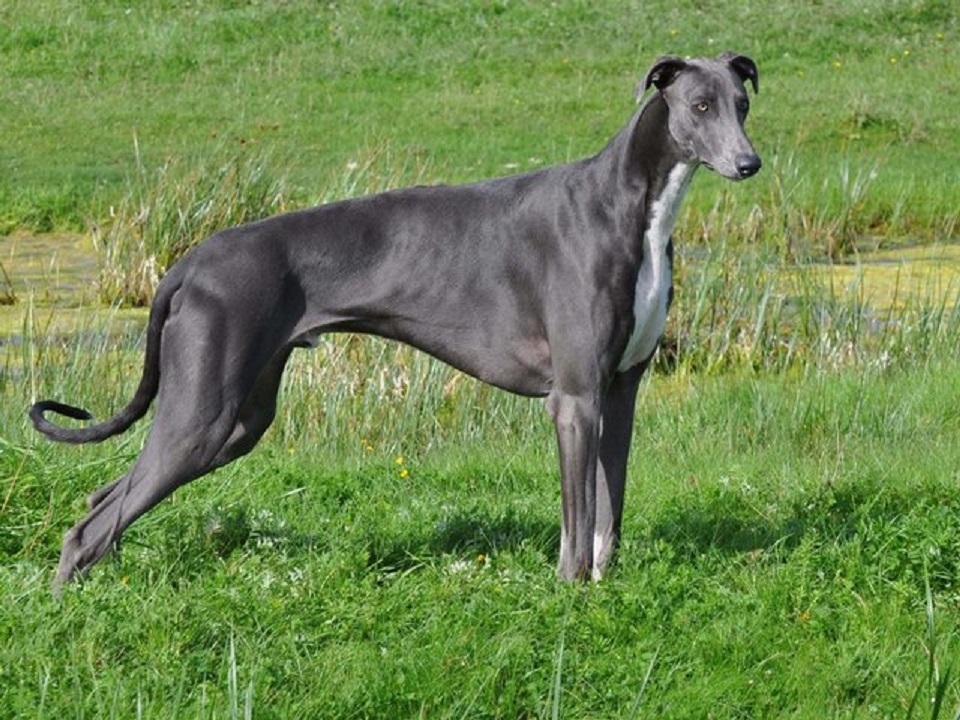
Greyhound

Navigate through the tabs
Navigate through the tabs below to view the breed's info of your interest.
The breed's info is divided in four sections; namely:
the breed's history ,
the breed's main stats ,
the dog's potential health issues
and finally, how the breed scored in 26 different categories.
All the above information should give you a respectively good overview for the dog of your interest.
Dog Breed's Main Info
The Breed's History:
The breed's origin has in popular literature often romantically been connected to Ancient Egypt, in which it is believed "that the breed dates back about 4,000 years" a belief for which there is no scientific evidence. While similar in appearance to Saluki (Persian Greyhound) or Sloughi (tombs at Beni Hassan c. 2000 BCE), analyses of DNA reported in 2004 suggest that the Greyhound may not be closely related to these breeds, but is a close relative to herding dogs.
Historical literature on the first sighthound in Europe (Arrian), the vertragus, the probable antecedent of the Greyhound, suggests that the origin is with the ancient Celts from Eastern Europe or Eurasia. Greyhound-type dogs of small, medium, and large size, would appear to have been bred across Europe since that time.
All modern, pure-bred pedigree Greyhounds are derived from the Greyhound stock recorded and registered, firstly in the private 18th century, then public 19th century studbooks, which ultimately were registered with coursing, racing, and kennel club authorities of the United Kingdom.
Historically, these sighthounds were used primarily for hunting in the open where their keen eyesight is valuable. It is believed that they (or at least similarly named dogs) were introduced to the area now known as the United Kingdom in the 5th and 6th century BCE from Celtic mainland Europe although the Picts and other peoples of the northern area now known as Scotland were believed to have had large hounds similar to that of the deerhound before the 6th century BCE.
The name "Greyhound" is generally believed to come from the Old English grighund. "Hund" is the antecedent of the modern "hound", but the meaning of "grig" is undetermined, other than in reference to dogs in Old English and Old Norse.
Its origin does not appear to have any common root with the modern word "grey" for color, and indeed the Greyhound is seen with a wide variety of coat colors.
The lighter colors, patch-like markings and white appeared in the breed that was once ordinarily grey in color.
The Greyhound is the only dog mentioned by name in the Bible; many versions, including the King James version, name the Greyhound as one of the "four things stately" in the Proverbs. However, some newer biblical translations, including The New International Version, have changed this to strutting rooster, which appears to be an alternative translation of the Hebrew term mothen zarzir.
But also the Douay-Rheims Bible translation from the late 4th-century Latin Vulgate into English translates "a cock."
According to Pokorny the English name "Greyhound" does not mean "grey dog/hound", but simply "fair dog". Subsequent words have been derived from the Proto-Indo-European root -g'her- "shine, twinkle": English grey, Old High German gris "grey, old", Old Icelandic griss "piglet, pig", Old Icelandic gryja "to dawn", gryjandi "morning twilight", Old Irish grian "sun", Old Church Slavonic zorja "morning twilight, brightness".
The common sense of these words is "to shine; bright".
In 1928, the very first winner of Best in Show at Crufts was Primley Sceptre, a Greyhound owned by H. Whitley.
Country of Origin:
England
Breed Group:
Hound
Height:
2 feet, 1 inch. to 2 feet, 6 inch. (63,5 to 76,2 cm)
Weight:
50 to 85 pounds (22,67 to 38,56 Kg)
Life Span:
12 to 15 years
Potential Health Issues:
Hypothyroidism,
Osteosarcoma,
Anesthesia Sensitivity,
Gastric Torsion (Bloat)
Adaptability
Apartment Living:
First Time Owners:
Sensitivity:
Being Alone:
Cold Weather:
Hot Weather:
Friendliness
Affection With Family:
With Kids:
With Dogs:
With Strangers:
Health and Grooming
Shedding:
Drooling:
Easy To Groom:
Overall Health:
Weight Gain Potential:
Size:
Training
Easiness:
Intelligence:
Mouthiness:
Prey Drive:
Barking or Howling:
Wanderlust:
Need For Exercise
Energy Level:
Intensity:
Exercise Needs:
Playfulness:
Our Mobile Application
Check out Our Mobile Application "Dog Breeds Central"
